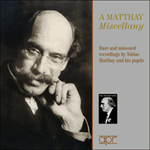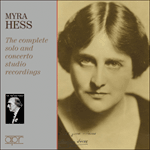‘The ever-phenomenal Marc-André Hamelin breaks out into the light with a two-disc set of Haydn sonatas … these are astonishing performances … Hyperion's sound and presentation are, as always, immaculate’ (Gramophone)
‘Hamelin kicks off with the late C major Sonata, Hob XVI:50, nailing his virtuoso credentials firmly to the mast with a mercurial account of its opening movement … Hamelin's playing is dazzling … these are altogether splendid performances … these beautifully recorded performances can't be recommended too highly’ (BBC Music Magazine)
‘This French-Canadian pianist is equal to anything … marvels of dexterity coupled with the most refined art … the fast pieces are preturnaturally smooth, the slow ones beautifully expressive’ (The Independent)
‘Hamelin's coruscating virtuosity and colouristic flair can be taken for granted. But his phenomenal technique is never an end in itself. This is playing of elegance, subtlety and a subversive Haydnesque wit. Hamelin delights in the composer's penchant for wrong-footing the listener. The madcap scherzo finale of No 50, with its outrageous pauses and deflections to the most improbable keys, is deliciously timed … elsewhere, Hamelin conjures a wonderful of veiled inwardness in the adagio of No 46, and an almost Chopin-like poetry in the dreamy F minor siciliano in No 23. But Hamelin's exhilarating reading has its own validity, while the finale is dazzling in its brio and comic legerdemain. This is just the sort of Haydn playing—colourful, inventive, impish—that should win these sonatas a wider following’ (The Daily Telegraph)
‘For those interested in Haydn (which should include everyone who cares about music) this is a particularly valuable release … every work on this set is worthy of repeated hearings … Hamelin is a stylish and accomplished pianist. His tone is aptly lean with no untoward use of the sustaining pedal or imposition of an undue rupturing of pulse. His runs are immaculate, even in the most rapidly articulated passages, and textures are always sharply focused … a special virtue of this release is the inclusion of an essay by Richard Wigmore. Providing cogent information that touches a variety of issues impossible to glean from a single source, it stands, in effect, as a model of what insert notes should be and rarely are. Throughout both CDs the sound is ideal’ (International Record Review)
‘Hamelin's gift for making light of complex textures and technically taxing writing is here harnessed to music of Classical clarity and economy. It is without doubt one of his finest achievements—and that's saying something. This cleverly chosen selection of diverse character is played with masterly resourcefulness. Hamelin can do deadpan humour (the finale of No 40) and brilliant note-spinning (No 32) like few others, but also finds a truly affecting wistfulness in some of the slow movements. Superbly recorded, this is a life-enhancing release’ (Classic FM Magazine)
‘Marc-André Hamelin joyfully tackles ten of the later sonatas on his generously presented two-for-one release from Hyperion, and one cannot but be intoxicated by such happy piano playing’ (Pianist)
‘Marc-André Hamelin's virtuosity is in a different league altogether. The pearly evenness of his touch, his immaculate negotiation of even the trickiest of figurations and nonchalant despatch of semiquavers at the highest velocity, indulges the physical exhilaration of Haydn's playful inspiration in a way unmatched by any pianist past or present … even Hamelin has made few discs to equal this and none finer’ (International Piano)
‘Hamelin begins his tour with the Sonata No 50 in C, Hob XVI:50 … the teasing opening and brusque outbursts in the opening movement are fully rendered by Hamelin, who embraces the cheeky syncopations, as well. There's something heartbreaking about Hamelin's playing in the tender Adagio to Sonata No 46 in A flat, Hob XVI:41. The single line, unsupported by any left-hand accompaniment rises and falls like a lullaby, gaining definition when Haydn finally brings in the left hand. There's more where that came from in the Adagio to Sonata No 23 in F, Hob XVI:23, which Hamelin treats as if it were a lost opera aria. Hamelin places the harmonic accents in just the right place, and he does it again and again over two discs’ (Time Out Chicago)
‘These superb performances—brisk, witty, emotionally evocative—reflect glory on him and Haydn alike … Hamelin is equally commanding through all of the composer's moods, skipping nimbly across the keyboard with unerring precision and then turning a slow movement into a hauntingly eloquent dramatic solo. Best of all, he gets the jokes, which he brings forward without underlining them. The result is a series of buoyant renditions’ (San Francisco Chronicle)
‘It is literally true that almost every new disc by Hamelin is an adventure and a revelation-in waiting. Should anyone ask why a pianist as technically daunting and so usually given to difficult and unusual repertoire (Alkan, Ornstein, Wolpe, Busoni) is now essaying two discs of piano sonatas by good old 'Papa' Haydn, all you have to do is listen to the opening C major Piano Sonata No 50 and you know you’re a long way from music intended to be pedagogic and little else. There is extravagance here of the sort Hamelin has always fed on all through this marvelous two disc set and Hamelin’s inclination toward whirlwind, occasionally almost violent prestos, Lisztian slow tempos and Bachian counterpoint brings out the bracing musical mind that so many of the greatest musicians have long insisted on beneath the classical era's Viennese paterfamilias’ (The Buffalo News, USA)
‘Hyperion's recording is as usual excellent with a proper focus given to the piano without making it sound overtly domineering or presumptuous. Richard Wigmore's copiously detailed notes are essential reading for the discerning Haydn scholar and thus I have nothing left to add but a wholehearted recommendation for this rather excellent double CD set which incidentally is tantalizingly offered for the price of one’ (Classical.net)
‘Hamelin finds in this music what so many performers of Haydn miss—the universality of utterance, the almost Shakespearean range of emotions, hiding within the classicism of Haydn's musical language’ (La Folia, USA)


 A Matthay Miscellany - Rare and unissued recordings by Tobias Matthay and his pupils
A Matthay Miscellany - Rare and unissued recordings by Tobias Matthay and his pupils Myra Hess - The complete solo and concerto studio recordings
Myra Hess - The complete solo and concerto studio recordings
